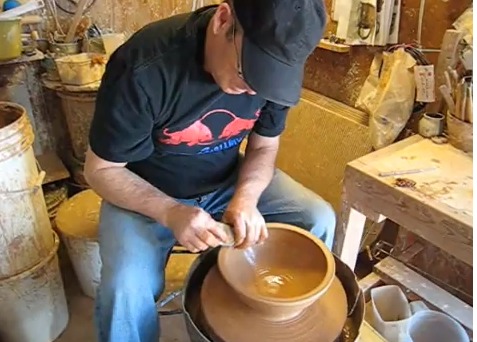Throw a pot on a wheel
Make a small clay pot on a pottery wheel, learning to center, shape, and smooth the clay with adult supervision and simple tools.



Step-by-step guide to throw a pot on a wheel
How to make a clay teapot - Ceramic teapot making on the wheel (15 minutes demo)
Step 1
Put on your apron so your clothes stay clean.
Step 2
Wedge the clay by kneading it until it feels smooth and has no air bubbles.
Step 3
Press the wedged clay firmly onto the center of the wheel head so it sticks.
Step 4
Turn the wheel on to a low steady speed.
Step 5
Wet your hands and the clay lightly with the sponge.
Step 6
Center the clay by holding steady pressure with both hands until it spins without wobbling.
Step 7
Press your thumbs down into the center to make an opening for the pot.
Step 8
Pull up the clay walls gently to make them taller and shape the pot.
Step 9
Smooth and refine the pot's shape by running the wooden rib over the outside and inside.
Step 10
Use the needle tool to tidy the rim and check the wall thickness at the top.
Step 11
Clean up and even the base by trimming away extra clay with a small tool.
Step 12
Cut the pot from the wheel head using the wire cutter or string.
Step 13
Lift your pot gently and place it on a towel in a safe spot to dry.
Step 14
Share a photo of your finished pot and what you learned on DIY.org.
Final steps
You're almost there! Complete all the steps, bring your creation to life, post it, and conquer the challenge!


Help!?
What can I use if I don't have a wooden rib, needle tool, or wire cutter?
Use a flexible plastic spatula or old credit card in place of the wooden rib, a knitting needle or skewer instead of the needle tool, and strong fishing line or a thin wire as an alternative to the wire cutter to cut the pot from the wheel head.
Why does my clay wobble when I try to center it and how can I fix it?
If the clay wobbles, stop the wheel, re-press the wedged clay firmly onto the center of the wheel head, then re-center by holding steady two-handed pressure with your hands and a lightly wet sponge while running the wheel at a low steady speed.
How can I adapt this wheel-throwing activity for different age groups?
For younger children, pre-center small balls of wedged clay, keep the wheel speed very low and guide their hands during 'press your thumbs down' and 'pull up the clay walls', while older kids can work at higher speeds, pull taller walls, refine shapes with the wooden rib and needle tool, and trim the base themselves.
What are simple ways to enhance or personalize my finished pot?
After smoothing with the wooden rib and tidying the rim with the needle tool, carve patterns before trimming the base, add colored slip or attach a handle after cutting the pot from the wheel head, then place it on the towel to dry and photograph it to share on DIY.org.
Watch videos on how to throw a pot on a wheel
How to Make Pottery | Kids Pottery Term Lesson
Facts about pottery and ceramics for kids
👐 Centering clay is often the trickiest part for beginners and can take several minutes of steady pressure and practice to master.
🌍 Fired pottery survives for millennia, which is why pottery shards are among the most common artifacts archaeologists find.
🔥 Kilns fire pottery at very high temperatures — many clays and glazes need about 1,000–1,300°C (1,832–2,372°F) to fully mature.
🧱 Potters commonly work with three main clay types: earthenware, stoneware, and porcelain — each feels and fires differently.
🎡 The potter's wheel has been used for thousands of years — archaeological evidence places early wheels in Mesopotamia around 3000 BCE.
How do I teach my child to throw a small pot on a pottery wheel?
What materials and tools do I need to make a small clay pot on a wheel?
What ages is throwing a pot on a wheel suitable for?
What safety tips should I follow when a child uses a pottery wheel?


One subscription, many ways to play and learn.
Only $6.99 after trial. No credit card required



